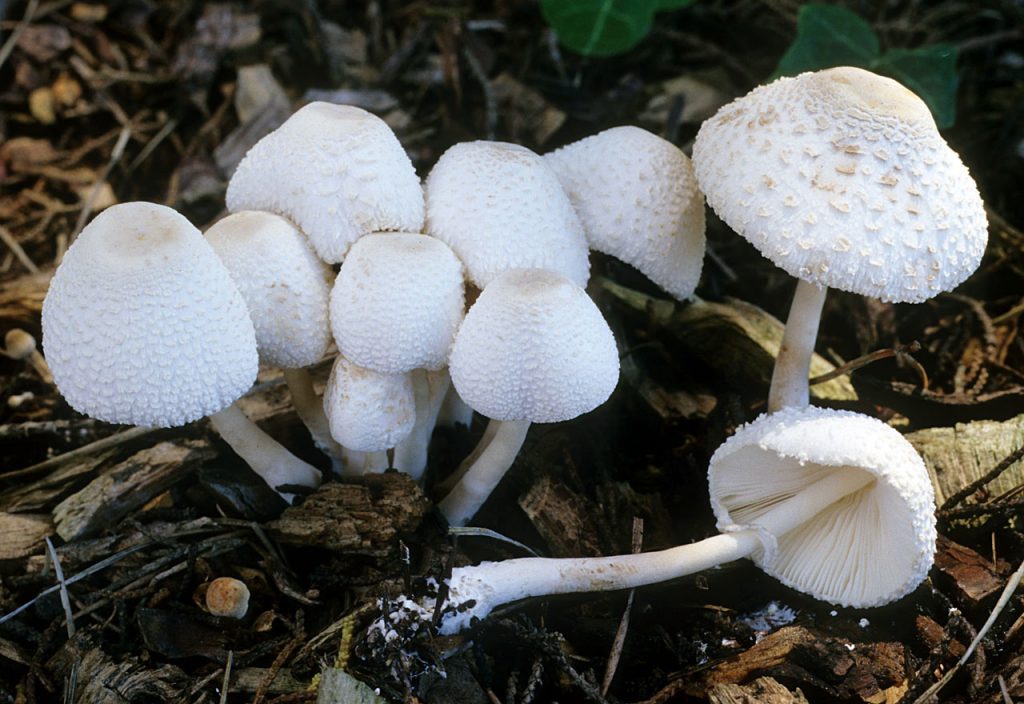Leucocoprinus cretaceus is a tropical to subtropical species of chalk-white mushroom covered in wart-like scales that is uncommonly found in North America and Europe within greenhouses and planter. [i]
The taxonomic history of this species is quite long as it has been classified and reclassified several times over the last two to three centuries. The first description of this species comes under the name of Agaricus cretaceus from the French botanist Jean Baptiste François Pierre Bulliard in 1788. He found specimens of this species (or according to some mycological sources a similar species, Leucocoprinus cepistipes) in hot greenhouses and closed glass enclosures in the warm summer months of July and August. Next, in 1836 the Swedish mycologist Elias Magnus Fries found a species with a similar description in Switzerland and classified it under the name of Pluteus cretaceus. Yet again in 1871 Paul Kummer, a German mycologist, found German specimens of this species and classified it under the name of Psalliota cretacea. Another French mycologist Claude Casimir Gillet similarly found French specimens of this species in cultivated gardens and vineyards and classified them under the name of Pratella cretacea. The Italian mycologist and botanist Oreste Mattirolo classified and reclassified this species first as Lepiota cretacea in 1898 and then as Lepiota cretacea in 1918. Beyond this, several other mycologists have also made attempts to classify this species (Leucoagaricus cretaceus M.M.Moser (1953), Lepiota cepistipes var. cretacea Saccarado (1887), Fungus cretaceus Kuntze (1898), etc). The classification and binomial name that stuck for this species can be attributed to a reclassification by the French mycologist Marcel Locquin. Locquin reclassified this species as Leucocoprinus cretaceus in 1945.
Due to the varied taxonomic history, it is no surprise that readers may come across numerous synonymous names for this species in various mycological texts. Some possible synonyms for this species include:
- Agaricus cretaceus
- Agaricus cepistipes var. cretaceus
- Coprinus cepistipes var. cretaceus
- Coprinus cepistipes ß cretaceus Gray
- Pluteus cretaceus
- Psalliota cretacea
- Pratella cretacea Gillet
- Lepiota cepistipes var. cretacea
- Fungus cretaceus
- Lepiota cretacea
- Leucoagaricus cretaceus
- Agaricus cretaceus var. ambiguus
- Psalliota cretacea f. grandis
- Lepiota cretata
- Leucocoprinus cretatus
From an etymological perspective, the epitaph cretaceus comes from the Greco-Latin word “creta” meaning chalk, referring to the chalk-like coloration of this specie’s cap.
Identification and Description [ii]
Cap: The cap of this species measures 2 to 8 cm in diameter. While young it is bulbous or hemispherical in shape, but as it grows with age it expands out becoming convex to nearly flat. The surface of the cap is chalk white, dry, and covered in minute, wart-like scales.
Flesh: The flesh is a similar white color as the cap and does not change in color when sliced or bruised.
Gills: This gills of L. cretaceus are free, closely spaced or crowded, thin, and are white.
Stem: The stem of this species measures 5-8 cm in length and has a circumference of 6-6mm at the apex and a circumference of 6-14 mm towards the base which is broader and swollen. The stem is concolorous with the cap and is also covered with soft wart-like scales. This species has a very fragile, white annulus.
Spore: The spores of this species measure 6–12 by 4–7 µm. They are smooth, ellipsoid to subamygdaliform, and thick walled with a small pore. When treated with potassium hydroxide (KOH) spores turn a slightly yellowish color.
Spore Print: The spore print of this species is white to creamy.
Flavor and Edibility: Whether this species is edible or not is not known. As such caution is advised and avoidance of its consumption is suggested.
Smell: This species does not have a specific or distinct odor.
Habitat: This species is saprobic. It can be found growing solitarily, scattered, or in loose clusters in greenhouses, planters, and potted plants.
Range: Although this species is known to uncommonly grow in North America as well as within the United States, its exact distribution is unknown. It is highly likely that specimens, if found, would be more commonly found in tropical and subtropical areas and states such as Tennessee, North Carolina, Georgia, Texas, and Florida.
Fruiting Season: The exact duration of this specie’s fruiting season is unknown. Some sources seem to suggest that it fruits year-round, while other mycological sources suggest a fruiting season that lasts from late summer and early fall.
Look-A-likes [iii] [iv]
The main look-a-like species that has to differentiated from L. cretaceus is Leucocoprinus cepistipes. Mycophiles should keep a few things in mind when trying to differentiate between these two species:
- L. cretaceus has a completely chalk-white cap, while L. cepaestipes has a whitish to pale brownish cap with a grayish brown center.
- L. cretaceus also has bone-like branching hyper on its cap surface.
- The wart-like scales of L. cretaceus are also helpful for setting it apart from the powdery and granular cap of L. cepaestipes.
- L. cretaceus is rare in North America and in the United States. Furthermore, it is more likely to be found growing in states with very warm climates, and only in planters, potted plants, and greenhouses.
- Cheilocystidia are the last aspect by which these two species can be differentiated.
- L. cretaceus – Cheilocystidia measure 35–75 by 7.5–15 µm. They are widely cylindric to widely fusiform or subcapitate, smooth, thin walled, occasionally with refractive apical encrustations, and hyaline in KOH.
- L. cepaestipes – Cheilocystidia measure 40–85 by 7.5–20 µm. They are clavate to lageniform, often becoming rostrate with a long, flexuous, irregular neck. They are thin-walled, smooth, and also hyaline in KOH.
References:
[i] Kuo, M. (2017, November). Leucocoprinus cretaceus.
[ii] Kuo, M. (2017, November). Leucocoprinus cretaceus.
[iii] Wood, M., & Stevens , F. (2020) California fungi: Leucocoprinus cepaestipes. MykoWeb.
[iv] Kuo, M. (2022, February). Leucocoprinus cepaestipes.


